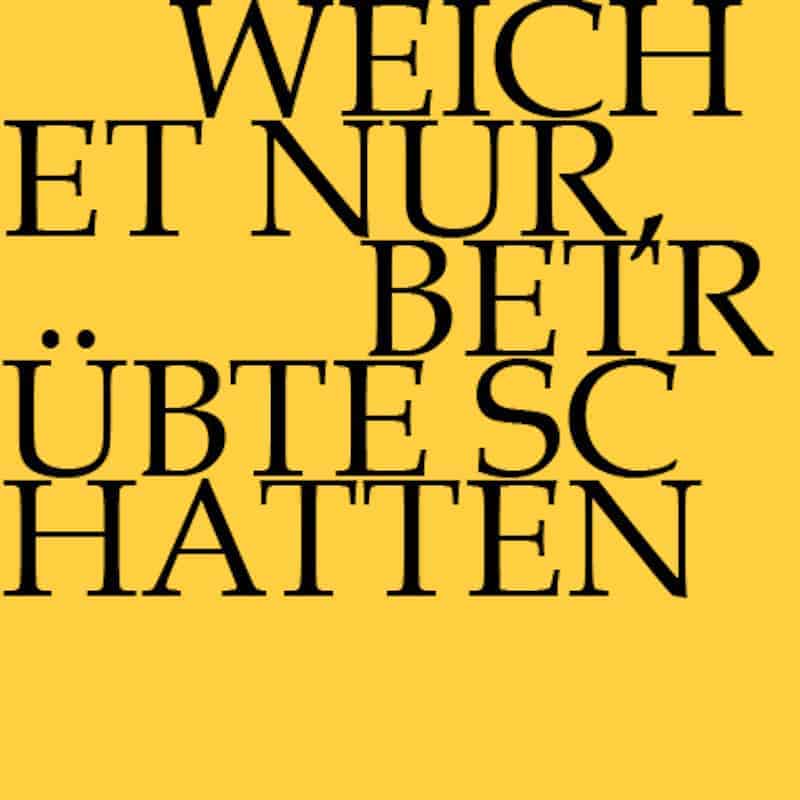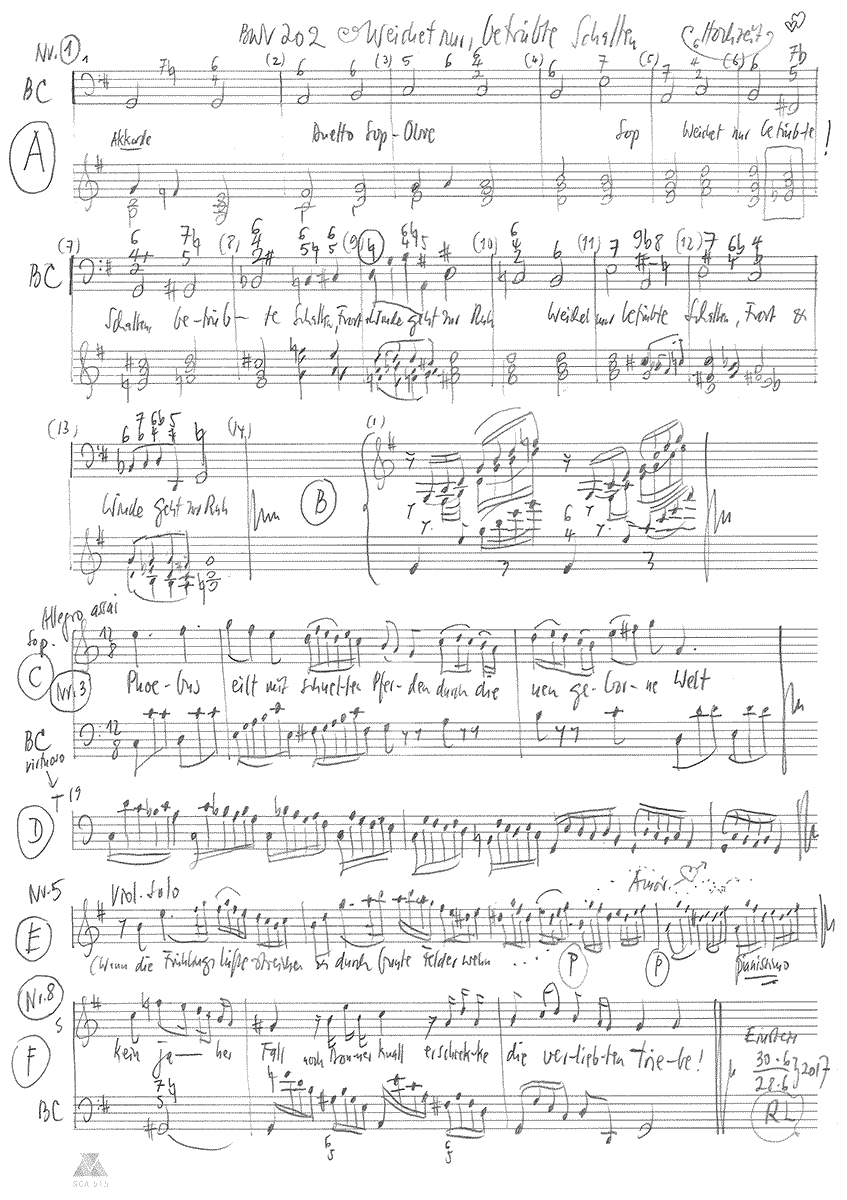Weichet nur, betrübte Schatten
BWV 202 // For a wedding
(Yield I say, ye brooding shadows) for soprano, oboe, strings and basso continuo

Would you like to enjoy our videos ad-free? Subscribe to YouTube Premium now...
Workshop
Reflective lecture
Bonus material
Soloists
Soprano
Carolyn Sampson
Orchestra
Conductor & cembalo
Rudolf Lutz
Violin
Lenka Torgersen, Ildikó Sajgó
Viola
Martina Bischof
Violoncello
Maya Amrein
Violone
Markus Bernhard
Oboe
Andreas Helm
Bassoon
Susann Landert
Musical director & conductor
Rudolf Lutz
Workshop
Participants
Karl Graf, Rudolf Lutz
Reflective lecture
Speaker
Gunhild Kübler
Recording & editing
Recording date
30.06.2017
Recording location
St. Gallen (Schweiz) // Einstein Saal
Sound engineer
Stefan Ritzenthaler
Director
Meinrad Keel
Production manager
Johannes Widmer
Production
GALLUS MEDIA AG, Switzerland
Producer
J.S. Bach Foundation of St. Gallen, Switzerland
Librettist
Text
Author unknown
First performance
Unknown
In-depth analysis
The extent to which Bach’s secular cantatas have always been overshadowed by his great sacred oeuvre, not to mention the exact number of secular cantatas that have been lost or misattributed, is illustrated by the fact that the only surviving copy (dated 1730) of cantata BWV 202 “Weichet nur, betrübte Schatten” (Yield I say, ye brooding shadows) stems from Bach’s circle of pupils in Thuringia. Although the cantata’s origin and purpose can only be surmised, the allusions to love and marriage in the libretto leave little doubt it was composed for a wedding. In the absence of Bach’s original score, however, it is impossible to determine whether the setting dates from his Weimar, Köthen or early Leipzig years – or perhaps all these stages. Consequently, the idea that the work was performed by Bach’s second wife, the trained soprano Anna Magdalena, must remain an appealing assumption.
Although information on the cantata is scant, the aura of spring evoked in the opening movements suggests it was performed in that season, which opens the possibility of linking the poetic expression of nature’s reawakening with the stirrings of love. From the very outset, the opening aria, with its ascending string figures and expressive oboe cantilena, depicts the misty shadows yielding to the warming spring sun with a delicacy and plasticity reminiscent of Handel’s most beautiful morning arias; in the lively middle section, it even surpasses them in finesse.
The recitative “Die Welt wird wieder neu” (The world again is new) appears to anticipate Goethe’s “Osterspaziergang” (Easter walk), affording the soprano a welcome opportunity to sing out in declamatory style. This gives way in the following aria to a gigue-like perpetuum mobile for solo voice and continuo that portrays Apollo (here under the name Phoebus) dashing through the “neugeborene Welt” (re-awakened world) – as if on the lookout for a new wife himself. Here, it seems fair to ask whether the high rank of this Greek god, who is traditionally associated with the arts and sciences, contains an allusion to the groom’s profession. The following recitative then addresses Amor’s “Vergnügnen” (pleasures), with the imitative figures that commence the arioso’s conclusion declaring with a charming wink that the blooming flowers will inevitably inspire ardent hearts.
The E-minor aria “Wenn die Frühlingslüfte streichen” (When the vernal breezes ramble) strikes a more fanciful, artistic tone featuring a violin and soprano duet of expansive figurations over a running bass. In this setting, Bach uses echo devices and caressing turns to magnificent effect, capturing the mischievous ways of the god of love and the secret delights of a pastoral tryst.
The love affair then takes a serious turn, and when the next recitative describes the true happiness to be found in the meeting of two souls, the keyword “Gunstgeschick” (lofty gift of fortune) may allude to either divine providence or a marriage arranged by higher circles. In this setting, no pastor could have expressed the blessing of marriage more beautifully than Bach’s enraptured final phrase.
In line with the libretto, however, the seasoned husband Bach then ups the ante. Set in a lively 3⁄8 metre, a cheeky tone and the embrace of an oboe and bassoon, the aria “Sich üben im Lieben” (To practise sweet courtship) is a veritable lesson on marital harmony that commends the cultivation of levity and spontaneity while equally acknowledging the virtue of fidelity that outlasts all passing fancies. Accordingly, the final recitative expresses a comprehensive blessing, which, by being declared aloud, seeks to spare “die verliebten Triebe” (the devoted passion) all the hardships of inconstancy as well as inner and outer turmoil.
In the closing aria “Sehet in Zufriedenheit tausend helle Wohlfahrtstage” (Witness in contented bliss thousand radiant days of favour), the tutti instrumentation of the opening movement returns, and the wedding celebrations seem already in full swing in an energetic gavotte. No doubt this is one reason why the music and text, after the standard allusion to the desire for offspring, do not linger but usher the bridal couple and guests directly to the buffet – laid out, it is to be hoped, in the happiest of spring weather.
Libretto
1. Arie
Weichet nur, betrübte Schatten,
Frost und Winde, geht zur Ruh!
Florens Lust will der Brust
nichts als frohes Glück verstatten,
denn sie träget Blumen zu.
2. Rezitativ
Die Welt wird wieder neu,
auf Bergen und in Gründen
will sich die Anmut doppelt schön verbinden,
der Tag ist von der Kälte frei.
3. Arie
Phoebus eilt mit schnellen Pferden
durch die neugeborne Welt.
Ja, weil sie ihm wohlgefällt,
will er selbst ein Buhler werden.
4. Rezitativ
Drum sucht auch Amor sein Vergnügen,
wenn Purpur in den Wiesen lacht,
wenn Florens Pracht sich herrlich macht,
und wenn in seinem Reich,
den schönen Blumen gleich,
auch Herzen feurig siegen.
5. Arie
Wenn die Frühlingslüfte streichen
und durch bunte Felder wehn,
pflegt auch Amor auszuschleichen,
um nach seinem Schmuck zu sehn,
welcher, glaubt man, dieser ist,
daß ein Herz das andre küsst.
6. Rezitativ
Und dieses ist das Glücke,
daß durch ein hohes Gunstgeschicke
zwei Seelen einen Schmuck erlanget,
an dem viel Heil und Segen pranget.
7. Arie
Sich üben im Lieben,
in Scherzen sich herzen
ist besser als Florens vergängliche Lust.
Hier quellen die Wellen,
hier lachen und wachen
die siegenden Palmen auf Lippen und Brust.
8. Rezitativ
So sei das Band der keuschen Liebe,
verlobte Zwei,
vom Unbestand des Wechsels frei!
Kein jäher Fall
noch Donnerknall
erschrecke die verliebten Triebe!
9. Arie (Gavotte)
Sehet in Zufriedenheit
tausend helle Wohlfahrtstage,
daß bald bei der Folgezeit
eure Liebe Blumen trage!



